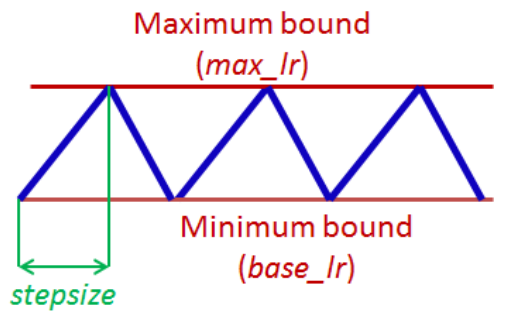Cyclical Learning Rates
What is it ?
It's a technique introduced in this paper: Cyclical Learning Rates for Training Neural Networks, written by Smith, Leslie N.
That suggests that rather then training a neural network with a fixed learning rate. It is more benefical to train it with a learning rate that cyclically vary between reasonable boundary values (even thought it may harm it during parts of the training, but overall it is more benfical).
From now on we will call the cyclical learning rate policy as CLR.
Why does it work ?
An intuitive understading of why CLR works is that when you consider your loss function, sometimes it will have plateaus when the gradient is really small, and that will slow the training process. So by variying the learning rate, you will pass those plateaus more rapidly (when the learning rate gets to the higher values).
Definitions
The policy is desribed by the following image.
We have four main things:
- Maximum bound (max_lr), the highest learning rate value.
- Minimum bound (base_lr), the lowest learning rate value.
- Step size, the number of iterations that are needed to go from base_lr linearly to max_lr.
- Cycle is just 2 x Step, going from min_lr to max_lr then going back to min_lr.
Implemetation
CLR comes in 3 variations, as described in the paper, however in this post we will implement one of them which is called triangular (the idea stays the same for the other two, but with some subtleties).
We will implement it by training a simple Neural Network using the famous MNIST dataset.
As mentioned by the author, the accuracy results are quite robust to cycle lengths. So in our case we will just use step size = 2 * number of iterations per epoch.
Now the number of iterations per epoch is just :
number_iterations_per_epoch = np.floor(total_num_of_items / batch_size).astype('int') + 1
number_iterations_per_epoch
step_size = number_iterations_per_epoch * 2
step_size
We'll set the requirements for training (i.e. a loss, the model, and gradient step)
loss_func = nn.CrossEntropyLoss() # Create cross entropy loss function
def one_iteration():
# set the optimizer that will do the gradient step for us
opt = SGD(simple_net_CLR.parameters(), current_lr)
# Get the activations
preds = simple_net_CLR(xb)
# Calculate the loss
loss = loss_func(preds, yb)
# Calculate the gradient
loss.backward()
# Do the step and set the gradient to zero
opt.step()
opt.zero_grad()
Choose the boundaries
Now something that is really interesting in the paper, is that the author gives us a quite efficient ways of choosing our base_lr and max_lr. Which he calls “LR range test”.
The idea is to train our model for a few epochs while increasing the learning rate linearly from a small value to a big value.
Then plot the accuracy according to the learning rate.
Note the learning rate when the accuracy starts improving, and when the accuracy slows, becomes ragged or starts to fall. And set the first as your base_lr and the latter as your max_lr.
simple_net_CLR = nn.Sequential(
nn.Linear(28*28, 30),
nn.ReLU(),
nn.Linear(30, 10)
)
# Create the NN with 2 linear layers and one non linearity (Relu) between them
start_lr = 0.0001 # Set the starting learning rate and the final one
final_lr = 1
# Create a numpy array with 314 values evenly spaced out from start_lr to final_lr
lr_range = np.linspace(start_lr, final_lr, 314)
# Get our batches of items
batches = list(dl)
# List where we will store the accuracy after each batch
batch_acc_v = []
# 314 is just an arbitrary number you can choose whatever works for you
for i in range(314):
# Get the batch
xb, yb = batches[i]
# Set the learning rate
current_lr = lr_range[i].item()
# Do the iteration with the given learning rate
one_iteration()
# Calculate the accuracy and save it in the previously created list
ba = tensor([accuracy(simple_net_CLR(xb), yb) for xb, yb in dl_valid]).mean().item()
batch_acc_v.append(ba)
plt.plot(lr_range, batch_acc_v); # Plot the accuracy according to learning rate
From the graph, we can reasonably choose base_lr = 0.175, max_lr = 0.25
base_line_net = nn.Sequential(
nn.Linear(28*28, 30),
nn.ReLU(),
nn.Linear(30, 10)
)
# Create base line NN with the same architechture as the previous one
lr = 0.2 # Setting the learning rate
# List to store the accuracy after each epoch
batch_acc_v = []
# Training for 30 epochs
for i in range(30):
for xb, yb in dl:
# do one gradient step
one_iteration_base()
# Calculate accuracy after each epoch
ba = tensor([accuracy(base_line_net(xb), yb) for xb, yb in dl_valid]).mean().item()
batch_acc_v.append(ba)
print('Best accuracy: ', max(batch_acc_v))
Now that we have everything we need, let's train the model and see the results.
base_lr = 0.175 # Set the learning rates
max_lr = 0.25
current_lr = base_lr
# Set the values of the learning rates for each part of the cycle
values_of_lr_as = np.linspace(base_lr, max_lr, step_size)
values_of_lr_ds = np.linspace(max_lr, base_lr, step_size)
# To know if we are in the first part of the cycle or the second (ascending / descending)
smaller_values = True
# when iter == stepsize we will change from ascending to descending ad vice versa
iter = 0
epochs = 30
batch_acc_v = []
for i in range(epochs):
for xb, yb in dl:
# one iteration
# take gradient step
one_iteration()
# increment bacause we did one iteration
iter += 1
# if yes change from descending to ascending and vice versa
if iter == step_size :
if smaller_values:
smaller_values = False
iter = 1
else:
smaller_values = True
iter = 1
if smaller_values:
current_lr = values_of_lr_as[iter].item()
else:
current_lr = values_of_lr_ds[iter].item()
# Calculate the accuracy after each epoch
ba = tensor([accuracy(simple_net_CLR(xb), yb) for xb, yb in dl_valid]).mean().item()
batch_acc_v.append(ba)
print('Best accuracy: ', max(batch_acc_v))
The CLR is a clear winner, as it achieved 97.10 % accuracy as opposed to 96.75 % for the fixed learning rate policy.
The author also suggests to stop the training at the end of the cycle as it is the moment where the learning rate gets to the lower values.
